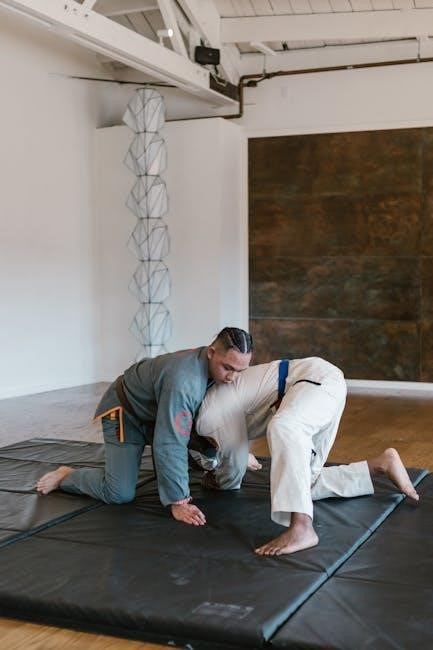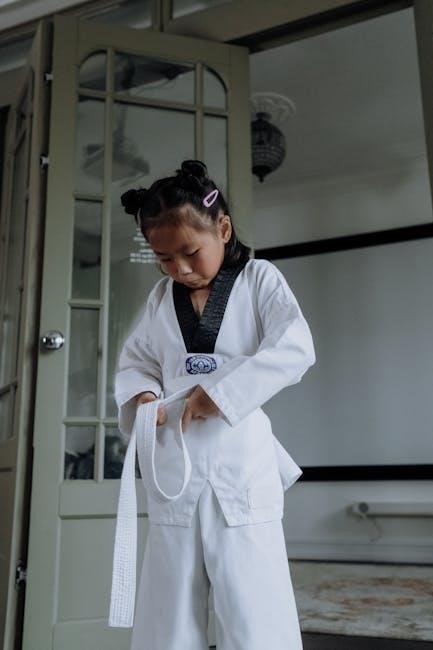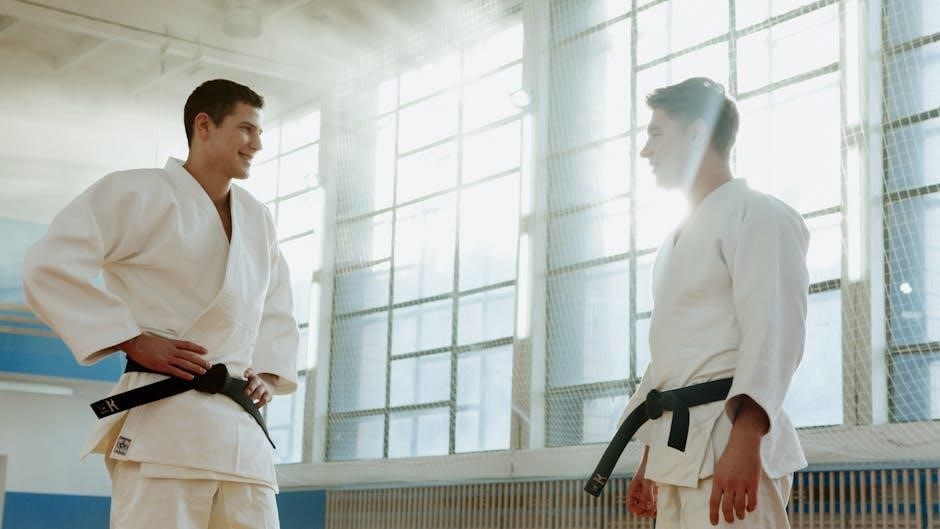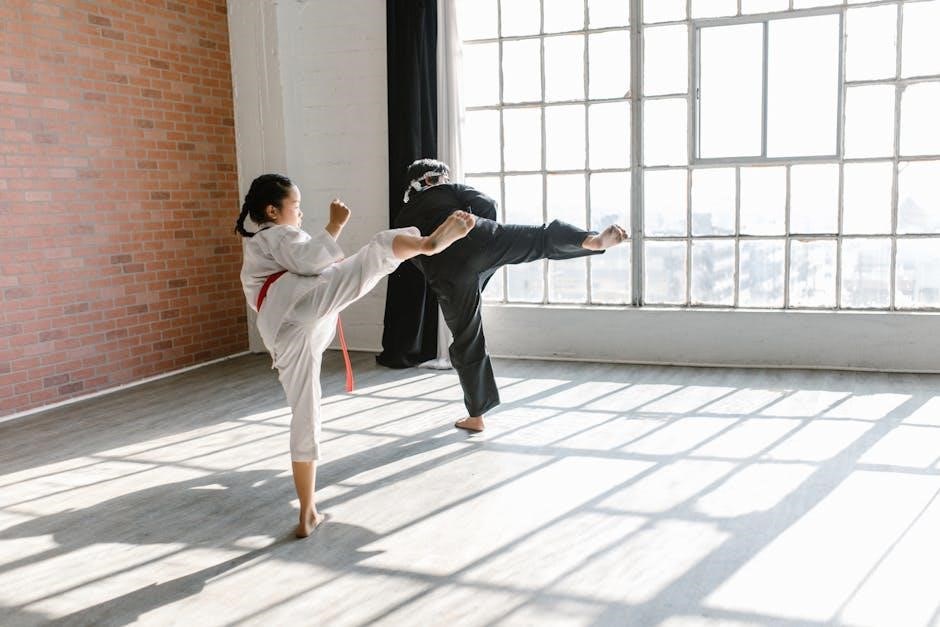A proper-fitting karate uniform enhances comfort, performance, and confidence. This guide simplifies sizing, ensuring a perfect fit for all practitioners, from beginners to experts, covering key measurements and fabric types.

Understanding the Components of a Karate Uniform

A karate uniform includes a jacket, pants, and belt, each designed for comfort and mobility. Proper fit ensures optimal performance, with measurements tailored to height, weight, and body proportions for all skill levels.
Jacket Measurements
Accurate jacket measurements are crucial for a comfortable and functional karate uniform. The total length is measured from the shoulder seam to the bottom hem, ensuring the jacket falls just above the hip for optimal coverage. The shoulder seam length is the distance between the two shoulder seams, providing a snug yet relaxed fit across the chest. Sleeve length is measured from the sleeve hem to the armscye, ensuring sleeves reach the wrist for proper technique execution. These measurements vary by size and fabric type, with heavier fabrics offering a more structured fit. Proper jacket fit allows for full range of motion during kicks, punches, and stances. Ensuring the jacket is neither too tight nor too loose is essential for both performance and comfort. Referencing a size chart and considering shrinkage factors can help achieve the perfect fit for any practitioner.
Pant Measurements
Pant measurements are essential for ensuring comfort and mobility in a karate uniform. The waist measurement is critical, with most uniforms featuring an elastic waistband for a secure fit. The maximum open waist size (A) and closed size (B) are key factors, ensuring the pants stay in place during movements. The overall length (C) of the pants is measured from the waist hem to the pant hem, providing adequate coverage while allowing for proper technique execution. Inseam length is also important, as it affects how the pants fit during kicks and stances. Pants with side slits enhance mobility, while heavier fabrics offer durability. Proper fit ensures the pants are not too tight or restrictive, allowing for a full range of motion. Using a size chart and considering fabric weight can help achieve the perfect balance of comfort and functionality. Ensuring the pants fit well is vital for optimal performance in training or competition.
Belt Specifications
The belt is a crucial component of a karate uniform, symbolizing rank and achievement. Belts are typically made from durable materials like cotton or polyester, ensuring longevity through frequent use. The width and thickness of the belt vary slightly depending on the manufacturer, but standard widths range between 1.5 to 2 inches. The length of the belt is determined by the practitioner’s height and waist size, with most belts adjustable to fit securely. Properly tying the belt is essential for maintaining uniform integrity during training. Belts are available in various colors, each representing a specific rank within the karate system. When selecting a belt, consider the weight and durability to match your training intensity. Additionally, some belts feature reinforced stitching or tipping for a professional finish. Always follow care instructions to maintain the belt’s condition, as improper washing or drying can cause shrinkage or fading. A well-fitted, high-quality belt completes the uniform and enhances overall presentation.
How to Measure for Your Karate Uniform
Accurate measurements are key to a perfect fit. Measure height, weight, chest, waist, and inseam using a flexible tape measure. Ensure the tape is level and not too tight for precise sizing.
Measuring Height and Weight
Measuring height and weight is a crucial step in determining the right karate uniform size. Stand upright against a wall to measure height accurately, ensuring the tape measure is level with the top of your head. For weight, use a digital scale and record the measurement in kilograms or pounds. These measurements help align your body proportions with standard size charts, ensuring a balanced fit. Height often correlates with uniform length, while weight can indicate the appropriate fabric weight and size category. Accurate measurements prevent sizing errors and ensure comfort during training. Always refer to the specific size chart provided by the manufacturer, as sizing can vary between brands. By combining height and weight with other measurements, you can select a uniform that offers optimal mobility and comfort. This step is essential for both beginners and experienced practitioners to achieve the perfect fit.
Measuring Chest and Waist
Accurate chest and waist measurements are essential for a well-fitting karate uniform. To measure your chest, wrap a flexible tape measure around the fullest part of your chest, keeping the tape level and parallel to the floor. Ensure the tape is snug but not tight. For the waist, measure around the natural waistline, typically just above the hipbone. This measurement is crucial for determining the uniform’s jacket and pant sizes. Proper chest and waist measurements ensure the jacket fits comfortably across the torso and the pants sit correctly on the hips. These measurements also help in selecting the appropriate fabric weight and style. Always stand up straight and avoid slouching during measurement for accuracy. By combining chest and waist measurements with height and weight, you can achieve a uniform that offers both comfort and mobility. This step is vital for ensuring the uniform performs well during training and competitions.
Measuring Inseam

Measuring the inseam is crucial for determining the correct pant length in a karate uniform. To measure accurately, stand straight and place the end of a flexible tape measure at the base of the crotch. Run the tape along the inside of the leg, following the natural curve, down to the ankle bone. Ensure the tape is snug but not tight. This measurement helps ensure the pants are neither too short nor too long, providing optimal mobility and comfort during training. Proper inseam length is essential for maintaining the uniform’s appearance and functionality. For karate uniforms, the inseam measurement directly impacts the fit and comfort, especially during kicks and movements. Always measure on bare feet or socks to avoid discrepancies. By combining inseam with waist and chest measurements, you can achieve a balanced fit that enhances performance and confidence. Accurate inseam measurement is a key step in selecting the perfect uniform.
Choosing the Right Size for Your Karate Uniform
Selecting the correct size ensures comfort and mobility. Use size charts, consider fabric weight, and account for shrinkage. Proper fit enhances performance and confidence during training and competitions.
Using Size Charts Effectively
Size charts are essential for selecting the right karate uniform. They typically include measurements like height, weight, chest size, and inseam. To use them effectively, compare your body measurements with the chart to find the closest match. Note that different brands may have slight variations, so always refer to the specific chart provided by the manufacturer. Pay attention to details such as fabric type, as some materials may shrink after washing. For example, uniforms made from cotton blends may require considering shrinkage factors. Additionally, some brands, like Punok, run larger than standard sizes, so adjust your choice accordingly. By carefully following the size chart and understanding the specific characteristics of the uniform, you can ensure a comfortable and proper fit for optimal performance during training or competitions.

Understanding Fabric Types and Weight

Fabric type and weight play a crucial role in selecting a karate uniform. Common fabrics include cotton, polyester blends, and canvas. Cotton blends, such as 45% polyester and 55% preshrunk cotton, offer durability and comfort, making them ideal for training. Heavier fabrics, like canvas, are often used for competition uniforms due to their sturdiness. Weight categories, such as 8.5 oz for middle-weight uniforms, are designed to balance comfort and performance. Lighter weights are suitable for beginners, while heavier weights are preferred by advanced practitioners for their superior durability. Fabric choice also affects mobility and breathability, with some materials offering better moisture-wicking properties. Additionally, preshrunk fabrics minimize shrinkage after washing. Understanding these factors ensures you select a uniform that meets your training needs and preferences, providing both comfort and longevity.
Considering Shrinkage Factors
Shrinkage is a critical factor when selecting a karate uniform, as it can affect the fit after washing. Many uniforms are made from preshrunk fabrics, which minimize shrinkage, but natural fibers like cotton may still shrink slightly. To account for this, consider purchasing a uniform slightly larger than your current measurements. Check the care instructions to determine if the fabric is prone to shrinking. Some manufacturers, like Tokaido, use traditional measurements that long-term practitioners are familiar with, ensuring consistency. Additionally, fabrics blended with polyester tend to resist shrinkage better than 100% cotton. It’s also important to wash the uniform before the first use to gauge any size changes. Ignoring shrinkage factors can lead to a uniform that becomes too tight or ill-fitting over time, compromising both comfort and performance during training or competitions.

Common Mistakes to Avoid When Selecting a Karate Uniform
Ignoring body measurements, choosing the wrong fabric, and not considering weight categories are common errors. These mistakes can lead to discomfort and hinder performance during training or competitions.
Ignoring Body Measurements

One of the most common mistakes when selecting a karate uniform is ignoring body measurements. Many practitioners rely solely on height and weight, neglecting chest, waist, and inseam measurements. This oversight often leads to uniforms that are too tight or too loose, restricting movement and causing discomfort. Proper fit is essential for optimal performance, as it allows for a full range of motion during techniques like punches, kicks, and stances. Additionally, an ill-fitting uniform can be distracting and may not meet the standards required for competitions or belt tests. To avoid this, it’s crucial to take accurate measurements of all relevant areas and refer to a size chart specific to the brand and type of uniform. By doing so, you ensure a comfortable and functional fit that supports your training goals.
Selecting the Wrong Fabric Type
Selecting the wrong fabric type is a common mistake that can significantly impact the comfort and performance of your karate training. Karate uniforms are made from various materials, such as 100% cotton, cotton-poly blends, or specialty fabrics like ripstop. Lightweight fabrics are ideal for beginners or warm weather, while heavyweight fabrics are preferred for advanced practitioners or competitions. Choosing a fabric unsuitable for your training needs can lead to discomfort, restricted movement, or even premature wear. For example, a heavyweight gi may be too stiff for a beginner, while a lightweight one may not withstand intense training. It’s essential to consider your training intensity, climate, and personal preference when selecting fabric. Additionally, some brands offer pre-shrunk or treated fabrics to minimize shrinkage. Always check the fabric type and weight before purchasing to ensure it aligns with your needs and the standards of your dojo or organization.
Not Considering Weight Categories
Not considering weight categories is a frequent oversight when selecting a karate uniform, leading to poor fit and performance. Uniforms come in various weights, such as lightweight, middle-weight, and heavyweight, each designed for specific training levels and purposes. Lightweight uniforms are ideal for mobility and warm weather, while heavyweight ones are durable and suitable for intense training or competitions. Ignoring weight categories can result in a uniform that is either too restrictive or too flimsy, affecting comfort and functionality. For instance, a heavyweight gi may be too stiff for a beginner, while a lightweight one may not withstand rigorous practice. It’s crucial to align the uniform’s weight with your training intensity, personal preference, and the climate. Additionally, some brands offer specialized weights for different martial arts disciplines. Always check the weight category and its suitability for your needs to ensure optimal performance and longevity of the uniform. Proper weight selection enhances both comfort and training efficiency.

Expert Tips for the Perfect Fit
Ensure a comfortable and functional fit by trying uniforms before purchase, prioritizing mobility, and following care instructions to maintain quality and longevity of your karate uniform.
Trying on the Uniform Before Purchase
Trying on your karate uniform before purchasing is crucial for ensuring the best fit. This step allows you to assess comfort, mobility, and overall quality. When trying it on, pay attention to how the jacket and pants fit your body. The jacket should be long enough to cover your torso but not so long that it restricts movement. The sleeves should reach your wrists without being overly tight or loose. For the pants, check the waistband for a secure fit and ensure the length is appropriate for your inseam. Mobility is key, so perform a few stretches or kicks to see if the uniform allows for a full range of motion. If possible, try on the uniform after measuring yourself according to the size chart to confirm accuracy. This hands-on approach ensures you select a uniform that meets your needs for training or competition.

Ensuring Mobility and Comfort
Mobility and comfort are essential for optimal performance in karate. A well-fitting uniform allows for a full range of motion, ensuring you can execute techniques without restriction. Look for uniforms with side slits in the pants and gusseted crotches, which enhance flexibility during kicks and stances. The fabric type also plays a significant role; lighter weights are ideal for speed and agility, while heavier fabrics offer durability for intense training. Proper fit is key—avoid uniforms that are too tight, as they can restrict movement, or too loose, as they may get in the way. Additionally, consider the waistband style; elastic waistbands provide a secure fit without digging into your skin. Ensuring your uniform is both comfortable and functional will help you stay focused and perform at your best during training or competitions. Prioritize these factors to find a uniform that supports your martial arts journey. Proper fit ensures peak performance and lasting comfort.
Following Care Instructions
Proper care for your karate uniform ensures longevity, comfort, and hygiene. Always follow the manufacturer’s guidelines, as different fabrics require specific attention. Wash your uniform in cold water to prevent shrinkage and color fading. Avoid using bleach or harsh detergents, as they can damage the material or weaken the stitching. For heavier fabrics, a gentle cycle is recommended, while lighter fabrics may require hand washing. Reshape the uniform while damp to maintain its fit and prevent wrinkles. Drying should be done naturally, away from direct sunlight, to avoid fading. Ironing should be done on a low setting, especially for embroidered or printed designs. Regular washing after each use keeps the uniform fresh and odor-free. Proper care not only extends the life of your uniform but also ensures it remains comfortable and functional for training. By following these steps, you can maintain your karate uniform in pristine condition for years to come.
Conclusion
Selecting the right karate uniform size is crucial for optimal performance and comfort. By understanding measurements, fabric types, and care instructions, you can ensure a perfect fit. Avoid common mistakes like ignoring body measurements or choosing the wrong fabric. Expert tips, such as trying on uniforms and prioritizing mobility, further enhance your experience. Proper care extends the life of your uniform, keeping it fresh and functional. Whether you’re a beginner or an advanced practitioner, a well-fitting uniform supports your training and competitions. Use size charts effectively, consider shrinkage, and focus on quality materials. With this guide, you’re equipped to make informed decisions, ensuring your karate journey is both enjoyable and successful. A properly fitting uniform not only boosts confidence but also allows for unrestricted movement, helping you master your techniques with ease.
